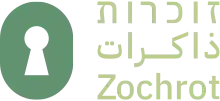 | |
| Founded | 2002 |
|---|---|
| Founder | Eitan Bronstein |
| Location |
|
Revenue | 280,000 euros in 2006 |
| Website | www |
Zochrot (Hebrew: זוכרות; "Remembering"; Arabic: ذاكرات; "Memories") is an Israeli nonprofit organization founded in 2002. Based in Tel Aviv, its aim is to promote awareness of the Palestinian Nakba [1]("Catastrophe"), including the 1948 Palestinian expulsion and flight.[2] The group's director is Eitan Bronstein. Its slogan is "To commemorate, witness, acknowledge, and repair".[3]
Zochrot organizes tours of Israeli towns, which include taking displaced Palestinians back to the areas they fled or were expelled from in 1948 and afterwards.[4] The group erects street signs giving the Palestinian history of the street or area they are in. Zochrot sees this as causing "disorder in space", raising questions about naming and belonging. A key aim is to "Hebrewise the Nakba" by creating a space for it in the public discourse of Israeli Jews.[2]
The word "Zochrot" uses the feminine plural present tense form of the Hebrew verb "to remember", whereas it is customary in Hebrew to use the masculine plural form when referring to a group of people. The feminine form was chosen to signal Zochrot's approach toward the Nakba, which the group says challenges what it sees as the masculine historical narrative by focusing on compassion and inclusion.[2]
Publications
The magazine of the group bears the name Sedek (English: rupture/rift) and was published for the fourth time in spring 2010. This issue contains more than 40 poems by Israeli poets, which were published in the period between 1948 and 1958. The poems reflect the views of the authors on the displacement of the Palestinians in the years around the foundation of Israel.
In 2012, Zochrot and Pardes Publications published a guidebook Omrim Yeshna Eretz ("Once Upon a Land – a Tour Guide") in Arabic and Hebrew, which is "designed to educate Jewish-Israelis about how their towns and cities were founded in an effort to reconcile them with the original inhabitants of the land".[5][6] It provides tours of 18 localities, mostly the sites of Palestinian villages depopulated in 1948.[5][6] While Zochrot translates the title "Omrim Yeshna Eretz" into English as "Once Upon a Land", a more literal translation would be "They Say There Is a Land". "Omrin Yeshna Eretz" is a popular song and Israeli folk dance[7] based on a poem by Shaul Tchernichovsky first published in a 1929 collection.[8][9]
Funding

According to its 2010 annual report, Zochrot listed the following groups as contributors: EKS-EPER, Trócaire, CCFD, Broederlijk Delen, MISEREOR, ICCO-KerkinActie, Oxfam GM, Oxfam Solidarity, Mennonite Central Committee, Medico International.[10] The group did not list its annual income.[10] In its 2006 annual report, the group declared a total income of 280,000 euros and listed the Mennonite Central Committee, Kerkinactie, ICCO, Cimade, CCFD, EPER/HEKS, Broederlijk Delen, Oxfam Solidarity Belgium, Misereor, Medico International, and Zivik as contributors.[11]
In 2012, the German federal organization Foundation Remembrance, Responsibility and Future (commonly referred to by its German acronym, EVZ), which provides financial compensation to victims of forced labor and other Nazi atrocities during the Holocaust, announced that they would no longer support Zochrot due to Zochrot's support for the Palestinian right of return.[12]
iNakba
In 2014, Zochrot launched iNakba, a mobile app that uses GPS technology to allow users to locate and learn about Palestinian villages that were destroyed during and after the Nakba.[13][14][15]
See also
Notes
- ↑ "Zochrot". Foundation for Middle East Peace. Retrieved 18 December 2023.
- 1 2 3 Bronstein, Eitan. "The Nakba in Hebrew: Israeli-Jewish Awareness of the Palestinian Catastrophe and Internal Refugees", in Masalha, Nur. (ed.) Catastrophe Remembered: Palestine, Israel and the Internal Refugees. Zed Books, 2005.
- ↑ Zochrot, the website in English, accessed 9 February 2010.
- ↑ Rinat, Zafrir (13 June 2007). "Out of sight maybe, but not out of mind". Haaretz.
- 1 2 "Whose land is it anyway?". The Economist. 15 April 2013.
- 1 2 Moshe Gilad (7 December 2012). "The Arab villages that were; a new Israeli guidebook". Haaretz.
- ↑ "Omrim Yeshna Eretz - Amir Sela". Aura Levin Lipski.
- ↑ "שאול טשרניחובסקי (1875–1943)" [Shaul Tchernichovsky (1875–1943)] (in Hebrew). Project Ben-Yehuda.
- ↑ "Sounds Israeli – Omrim Yeshna Eretz (They say there is a land)". UK Media Watch. 17 August 2013.
- 1 2 "2010 Annual Report p.40" (PDF). Archived from the original (PDF) on 4 March 2016. Retrieved 18 April 2013.
- ↑ Annual report 2006, Zochrot, accessed 9 February 2010.
- ↑ Toby Axelrod (2 February 2012). "German fund pulls NGO cash". The Jewish Chronicle. London.
- ↑ Schejter, Amit M.; Shomron, Baruch; Abu Jafar, Muhammad; Abu-Kaf, Ghalia; Mendels, Jonathan; Mola, Shula; Shacham, Malka; Sharha, Amneh; Tirosh, Noam (2023). Schejter, Amit; Shomron, Baruch; Abu Jafar, Muhammad; Abu Kaf, Ghalia (eds.). "Mobile Digital Applications: The Case of iNakba, Voice and Memory". Digital Capabilities: ICT Adoption in Marginalized Communities in Israel and the West Bank. Palgrave Studies in Digital Inequalities. Cham: Springer International Publishing: 91–107. doi:10.1007/978-3-031-22930-5_6. ISBN 978-3-031-22930-5. Retrieved 24 October 2023.
- ↑ Tirosh, Noam (September 2018). "iNakba , mobile media and society's memory". Mobile Media & Communication. 6 (3): 350–366. doi:10.1177/2050157918758130. ISSN 2050-1579. S2CID 169757373.
- ↑ Schejter, Amit M.; Tirosh, Noam (2016), Schejter, Amit M.; Tirosh, Noam (eds.), "iNakba and Realizing the Potential of New Media", A Justice-Based Approach for New Media Policy: In the Paths of Righteousness, Cham: Springer International Publishing, pp. 101–115, doi:10.1007/978-3-319-41510-9_8, ISBN 978-3-319-41510-9, retrieved 24 October 2023
